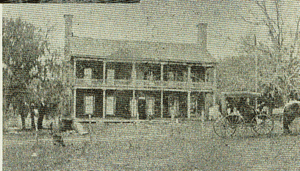Glenblythe Plantation facts for kids
The Glenblythe Plantation was a large farm in Gay Hill, Washington County, Texas. It was established in 1859. Before the American Civil War, people who were enslaved were forced to work on this plantation. The original plantation house is no longer standing, but a special marker was put up in 1967 to remember its history.
Contents
History of Glenblythe Plantation
Starting the Plantation
The Glenblythe Plantation was started in 1859 by Thomas Affleck. He was born in Scotland and was very interested in farming and plants. He also wrote books about farming. The plantation was located in a place called Gay Hill, which is now like a ghost town, near Brenham in Washington County, Texas. The name Glenblythe comes from a Scottish language and means "joyous valley."
The main house on the plantation was quite large, with two and a half floors. It had six bedrooms, two main halls, a kitchen, and rooms for laundry, storage, dining, and a parlor. There were also covered porches and long open porches along the sides. Nearby, there were many other buildings. These included a place for lumber, a carriage house for wagons, a granary for storing grain, stables for animals, and yards for chickens and pigeons. There were also houses for farmhands and a separate house for the overseer, who managed the daily work. About two miles away, there was a church, a hospital, a storehouse, and twenty more houses. There was also a sugar mill, a flour mill, a gin house for processing cotton, a press, a sawmill, and a blacksmith shop. Another house was there for the mill foreman.
Farming and Business
Glenblythe Plantation was mainly used for farming. It had fields of cotton, corn, barley, millet, hay, and sorghum. Thomas Affleck also raised many animals like sheep, cows, mules, oxen, and horses.
The plantation was home to one of the biggest and earliest plant nurseries in the southern United States, called "Central Nurseries." Thomas Affleck had studied farming at the University of Edinburgh in Scotland. He liked to try growing new crops and even found some plants that were special to the South. For example, he discovered a type of rose called the Old Gay Hill Red China, which is native to the Gay Hill area.
There was also a winery on the plantation. They made "mustang wine" from local mustang grapes, which they sold. Affleck even advertised his wine in some of his writings.
Enslaved People
In addition to the overseer and some white farmhands, about 120 black people were enslaved and forced to work on the Glenblythe Plantation. They were cared for by a black nurse and a doctor, who visited them at least once a month. Thomas Affleck wrote in his book, Cotton Plantation Record and Account Book, that it was important to provide enslaved people with enough food, clothing, and medical care. He also believed they should have access to Christian church services, thinking this would make them more productive. However, after the American Civil War ended, when slavery was abolished, Affleck faced financial difficulties.
The Civil War Years
The Glenblythe Plantation played a small part in the American Civil War, which lasted from 1861 to 1865. In 1862, Thomas Neville Waul, a general in the Confederate States Army, visited the plantation. While he was there, he organized a group of soldiers called the Waul's Legion. They used the plantation grounds as a camp. After the war ended and the South lost, Thomas Affleck rented out parts of his plantation to try and get back some of the money he had lost. He even advertised it in a newspaper called the New York Herald.


